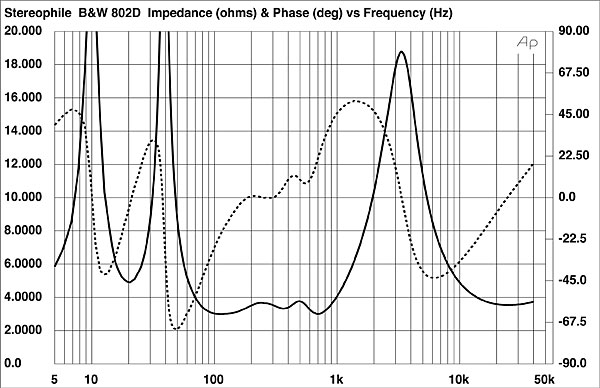Yes - we seldom talk about impedance peaks - mostly because they are easily handled by the vast majority of amps - Impedance peaks aren't a "problem"No one disagrees with the need of current in amps, others are just saying there is a need for voltage as well and of course ideally an amp should have both high voltage and high current capability. But that would, as you mentioned before, involved some "heavily engineered...", and obviously relatively expensive parts.
I just randomly googled the impedance graph of one of the often mentioned as a difficult load, see those high impedance peaks beagleman talked about?
Now we have both examples, one from you about the impedance dip to near 2 ohms and this one with peaks to higher than 20 ohms.
The Quad amp you mentioned before may not struggle with your low impedance speaker under some conditions but it would struggle with speakers that have such impedance peaks under certain conditions of use.
Again, I agree with you that there are amps designed to maintain excellent performance regardless of the impedance peaks and dips. That's in theory, in practice I am not ware (they probably do exist) of any power amp that are truly designed to perform equally well with speakers that have relatively high impedance peaks and low dips in the frequency range that have a lot of contents. McIntosh use output autotransormers (they call them autoformers) for impedance matching purposes but the user have to manually move the connections if they switch from 8 ohm to 4 ohm speakers, so it is still not ideal for speakers that have both high impedance peaks and low impedance dips I mentioned. That's just all theory, in practice also as you mentioned before, no one need to worry about sacrificing performance as there is always the option to just buy more "power". So if one needs 100 W/160 W 8/4 ohm amp, then just go for a 400/600 W 8/4 ohm amp and all those wonderful 20 ohm peaks and 2 ohm dips will be forgiven!!
By the way, for a relatively low cost solution, bridging a pair of AHB2 can also be a good option for those who has such speakers.
Bowers & Wilkins 802 D3 Diamond loudspeaker Measurements
Sidebar 3: Measurementswww.stereophile.com

And the other things is - even without "power doubling" as impedance drops - many of us make do, by purchasing massively overpowered amps, just so we can have sufficient at the low impedance!
I purchased the Crown XLS2500 at a very attractive price - but an XLS1500 would probably have done the job just as well. (the XLS2500 is 440W@8ohm, 1200W@20hm)
Talking about voltages... standard 1W SPL measurements are done at circa 2.8V... and to maintain that V at 2 ohm requires 4x the current
One can calculate the required V for the required SPL... it's a bit like looking at the other side of the same coin....
With my 86db SPL speakers at 2m, 2 speakers (stereo pair) -
1W@8ohm / 2.8V produces 83db SPL (4W@ 2ohm)
16W@8omh / 32V produces 95db SPL (64W@2ohm)
128W@8ohm / 90.5V produces 104db SPL (512W@2ohm)
So in a rough, manner, if you want to achieve 105db SPL at MLP (with 86db spl speakers) - you need and amp that can put out just under 95V into whatever impedance your speaker throws at it.... that means, for a speaker that has 2 ohm troughs in its impedance, it will need to be over 500W @ 2 ohm
And this, naturally, is where AVR's as a general genre, usually "hit the wall" - and where people like me, choose to use external amps, and very high powered ones - for all of those reasons.
It also shows up what power levels are needed (roughly) to achieve THX reference levels with a relatively inefficient set of speakers... 130W (@ 8ohm) is ample, no real need for 150W+ "monsters"..... but because of those 2 ohm troughs, we end up running 300W+ "monsters" - just so we can eke out the minimum power/voltage we need at 2 ohm without being constrained.
